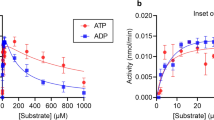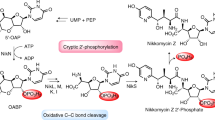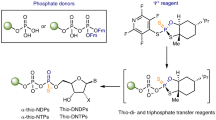Abstract
Deoxyribonucleoside kinases phosphorylate deoxyribonucleosides and activate a number of medically important nucleoside analogs. Here we report the structure of the Drosophila deoxyribonucleoside kinase with deoxycytidine bound at the nucleoside binding site and that of the human deoxyguanosine kinase with ATP at the nucleoside substrate binding site. Compared to the human kinase, the Drosophila kinase has a wider substrate cleft, which may be responsible for the broad substrate specificity of this enzyme. The human deoxyguanosine kinase is highly specific for purine substrates; this is apparently due to the presence of Arg 118, which provides favorable hydrogen bonding interactions with the substrate. The two new structures provide an explanation for the substrate specificity of cellular deoxyribonucleoside kinases.
This is a preview of subscription content, access via your institution
Access options
Subscribe to this journal
Receive 12 print issues and online access
$189.00 per year
only $15.75 per issue
Buy this article
- Purchase on Springer Link
- Instant access to full article PDF
Prices may be subject to local taxes which are calculated during checkout



Similar content being viewed by others
References
Thelander, L. & Reichard, P. Annu. Rev. Biochem. 48, 133–158 (1979).
Arnér, E.S.J. & Eriksson, S. Pharmacol. Ther. 67, 155–186 (1995).
Munch-Petersen, B., Piskur, J. & Sondergaard, L. J. Biol. Chem. 273, 3926–3931. (1998)
Munch-Petersen, B., Knecht, W., Lenz, C., Sondergaard, L. & Piskur, J. J. Biol. Chem. 275, 6673–6679 (2000).
Leoni, L.M. et al. Proc. Natl. Acad. Sci. USA 95, 9567–9571 (1998).
Niranjan, A. et al. Mol. Ther. 2, 114–120 (2000).
Ugur Ural, A. et al. Gynecol. Oncol. 76, 305–310 (2000).
Bennett, M.S. et al. FEBS Lett. 443, 121–125 (1999).
Brown, D.G. et al. Nature Struct. Biol. 2, 876–881 (1995).
Champness, J.N. et al. Proteins 32, 350–361 (1998).
Wild, K., Bohner, T., Folkers, G. & Schulz, G.E. Protein Sci. 6, 2097–2106 (1997).
Arpaia, E. et al. J. Exp. Med. 191, 2197–2207 (2000).
Hendrickson, W.A. & Ogata, C.M. Methods Enzymol. 276, 494–523. (1997).
Lavie, A. et al. Nature Struct. Biol. 4, 601–604 (1997).
Ostermann, N. et al. Structure Fold. Des. 8, 629–642 (2000).
Herrström Sjöberg, A., Wang L. & Eriksson, S. Mol. Pharmacol. 53, 270–273 (1998).
Branden, C. & Tooze, J. Introduction to protein structure (Garland Publishing, Inc., New York; 1999).
Knecht, W., Munch-Petersen, B. & Piskur, J. J. Mol. Biol. 301, 827–837 (2000).
Wang, L., Hellman, U. & Eriksson, S. FEBS Lett. 390, 39–43 (1996).
Otwinowski, Z. in Proceedings of the CCP4 study weekend (eds, Issacs N., Bailey, S. & Sawyer, L.) 56–62 (Daresburry Laboratories, Warrington, UK; 1993).
Terwilliger, T. http://www.solve.lanl.gov (2000).
de La Fortelle, E. & Bricogne, G. Methods Enzymol. 276, 442–494 (1997).
Abrahams, J. & Leslie, A. Acta Crystallogr. D 52, 30–42 (1996).
Jones, T.A., Zou, J.Y., Cowan, S.W. & Kjeldgaard, M. Acta Crystallogr. A 47, 110–119 (1991).
Brünger, A.T., et al. Acta Crystallogr. D 54, 905–921 (1998).
Navaza, J. Acta. Crystallogr. D 50, 157–163 (1994).
Cowtan, K. Joint CCP4 and ESF-EACBM Newsletter on Protein Crystallography 31, 34–38 (1994).
CCP4. The CCP4 Suite: Programs for Protein Crystallography. Acta Crystallogr. D 50, 760–763 (1994).
Kraulis, P. J. Appl. Cryst. 24, 946–950 (1991).
Acknowledgements
We would like to thank A.-E. Egholm for excellent technical assistance. This work was supported by grants from the Swedish Natural Science Research Council, the Swedish Strategic Research Foundation (to H.E and S.E.), the Swedish Cancer Foundation (to H.E.), the Danish Research Council (to J.P.) and the Swedish Medical Research Council (to S.E.).
Author information
Authors and Affiliations
Corresponding author
Rights and permissions
About this article
Cite this article
Johansson, K., Ramaswamy, S., Ljungcrantz, C. et al. Structural basis for substrate specificities of cellular deoxyribonucleoside kinases. Nat Struct Mol Biol 8, 616–620 (2001). https://doi.org/10.1038/89661
Received:
Accepted:
Issue Date:
DOI: https://doi.org/10.1038/89661
This article is cited by
-
Clinical and molecular characterization of three patients with Hepatocerebral form of mitochondrial DNA depletion syndrome: a case series
BMC Medical Genetics (2019)
-
Structure of mammalian respiratory complex I
Nature (2016)
-
Structural basis of the substrate preference towards CMP for a thymidylate synthase MilA involved in mildiomycin biosynthesis
Scientific Reports (2016)
-
The Phylogenetic Distribution and Evolution of Enzymes Within the Thymidine Kinase 2-like Gene Family in Metazoa
Journal of Molecular Evolution (2014)
-
Enhanced toxicity of purine nucleoside analogs in cells expressing Drosophila melanogaster nucleoside kinase mutants
Gene Therapy (2007)



